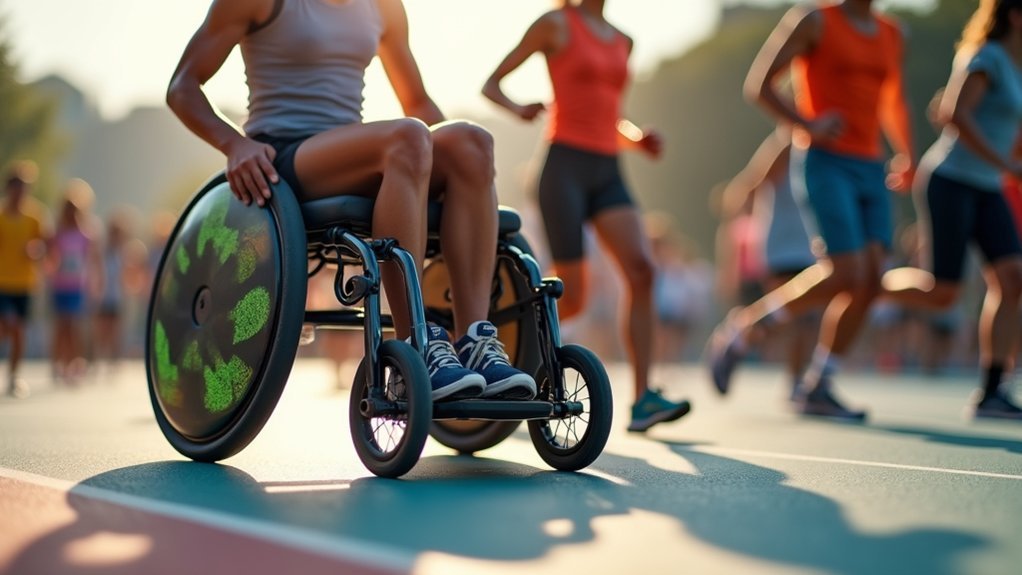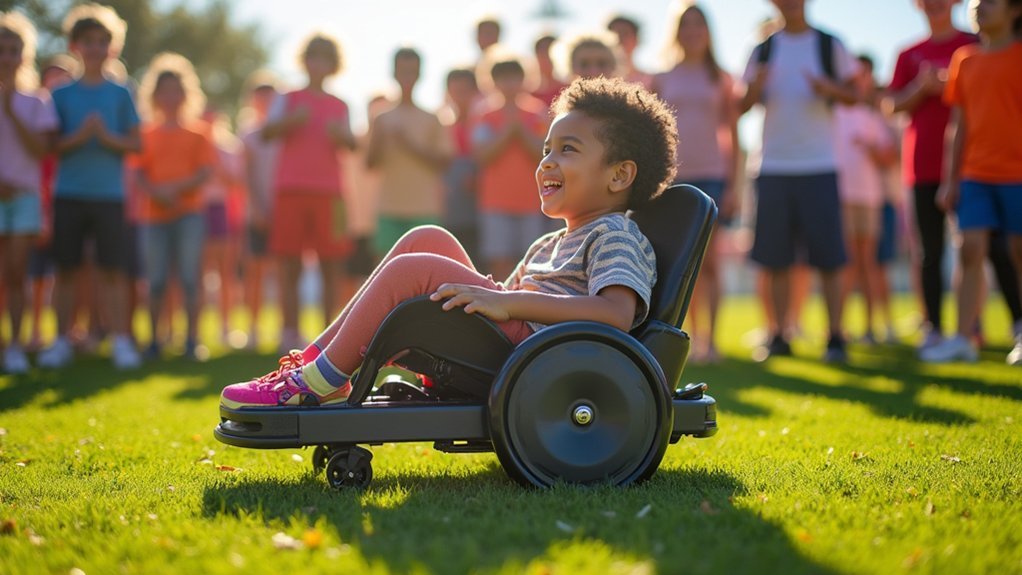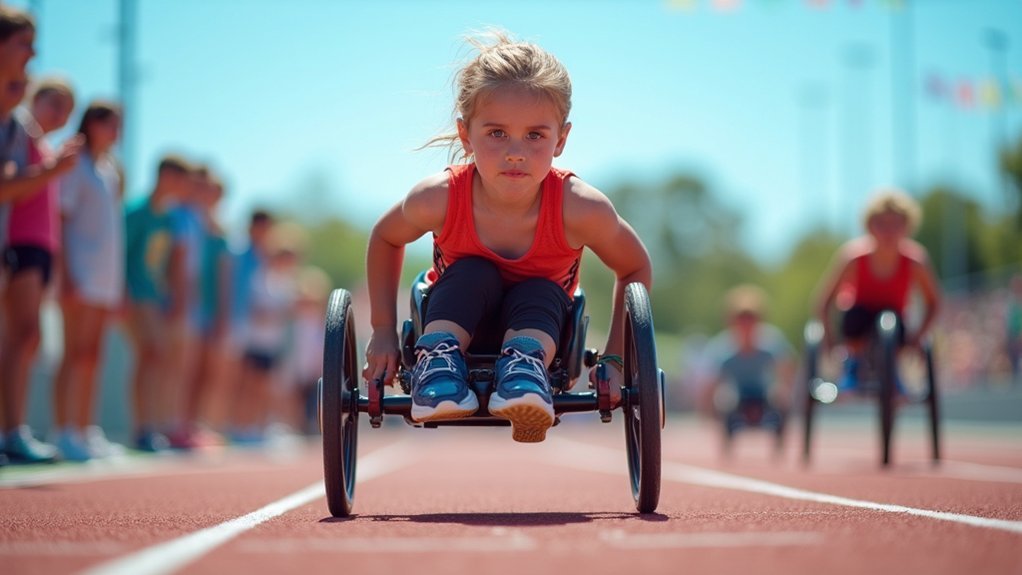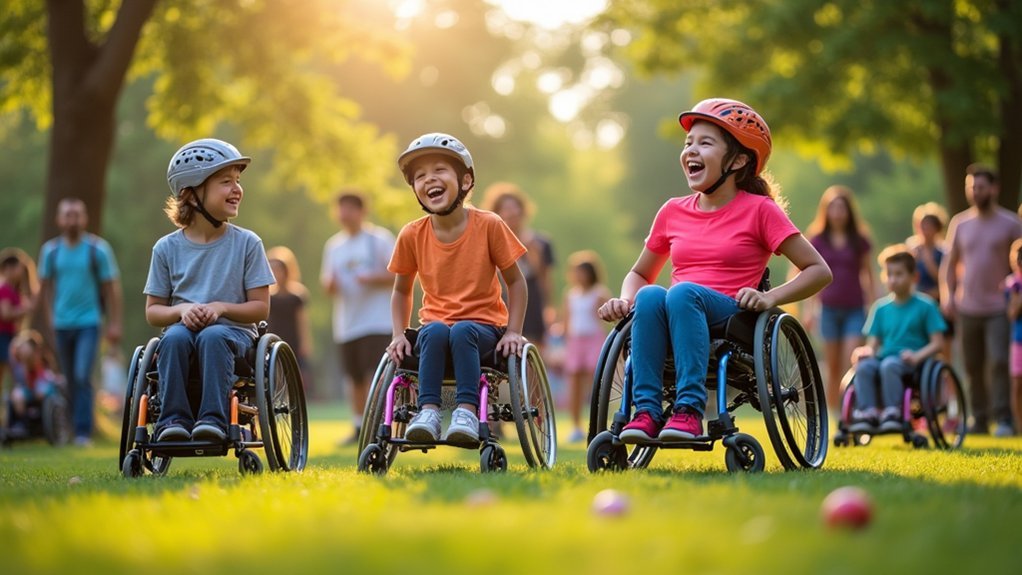Sensory-smart adaptive sports gear combines AI technology with real-time feedback to enhance your athletic performance. You’ll benefit from equipment that automatically adjusts to different terrains and responds intelligently to your unique movement patterns. These innovations reduce injury risk while providing personalized coaching through built-in sensory feedback. For athletes with disabilities, this gear builds confidence and expands access to previously challenging sports. Discover how these technological advancements can transform your competitive edge and athletic journey.
The Evolution of Smart Adaptive Sports Equipment

While sports participation offers universal benefits, people with disabilities have historically faced substantial barriers to full athletic engagement.
Today’s adaptive sports equipment has transformed this landscape, enabling unprecedented access to athletic pursuits. Equipment like the EvolutionVN Wheelchair Active Fitness Station provides users with over 200 exercises for strength training, rehabilitation, and fitness activities. You’ll find commercially available adaptive gear spans categories from specialized wheelchairs and prosthetics to custom bicycles, each designed for specific sports and disability requirements.
Adaptive equipment now spans specialized wheelchairs to custom bicycles, revolutionizing sports accessibility for all ability levels.
These innovations incorporate cutting-edge materials that improve durability while enhancing performance dynamics.
Despite technological advances, you might encounter significant barriers to access, primarily high costs and limited availability. These challenges directly impact physical and mental health outcomes for potential participants.
The good news? Ongoing research focuses on creating more accessible, personalized adaptive equipment. These developments are continually improving the integration of athletes with disabilities into competitive and recreational sports environments.
Personalized Performance Enhancement Through AI Technology
Modern AI-powered sports gear analyzes your unique movement patterns to identify inefficiencies and potential injury risks through millisecond-level motion tracking.
Your equipment actively adapts to your body’s changing needs during competition, shifting support structures and responsive elements based on detected stress points.
You’ll experience continuous performance improvements as these systems optimize your training regimen with personalized feedback loops that adjust difficulty levels precisely when your form begins to deteriorate. AI leverages sophisticated machine learning algorithms to minimize the risk of serious injuries by continuously monitoring and analyzing your performance data.
Individualized Movement Analysis
As athletes push the boundaries of performance, individualized movement analysis through AI technology has revolutionized training approaches. You’ll receive objective, data-driven insights that eliminate bias while optimizing your movement patterns for peak efficiency.
With platforms like VueMotion accessible via smartphone, you’re getting precision measurements of acceleration, speed, and force application wherever you train. These markerless systems capture your movements without bulky equipment, providing real-time feedback for immediate corrections. The intuitive platform requires only a smartphone and tripod for complete setup, minimizing disruption to valuable coaching time.
Your development becomes truly personalized as AI identifies your specific strengths and weaknesses, creating tailored training strategies while monitoring injury risks.
During rehabilitation, AI helps guarantee your safe return to competition through functional testing and progress tracking.
This technology offers you a competitive edge – whether you’re a professional athlete or weekend warrior – by making elite-level movement analysis accessible and actionable.
Instant Adaptation Capabilities
Thanks to revolutionary AI technology, your sports equipment now responds to your movements with unprecedented intelligence. Your gear actively adjusts based on real-time performance data, optimizing for your unique biomechanics and preventing injuries before they occur. Advanced lightweight materials like carbon fiber and titanium have dramatically enhanced the natural movement and maneuverability of adaptive sports equipment.
| Adaptation Feature | Benefit | Application |
|---|---|---|
| Motion Analysis | Customizes to your specific stride patterns | Running blades, wheelchairs |
| Fatigue Detection | Modifies responsiveness when you’re tired | All adaptive equipment |
| Weather Compensation | Adjusts settings for environmental conditions | Outdoor sports gear |
| Skill Progression | Evolves with your improving abilities | Training equipment |
You’ll experience fewer adjustment sessions as your equipment learns from each training period, continuously fine-tuning its settings. This intelligent adaptation extends equipment lifespan while maximizing your performance potential, turning every training session into an opportunity for improvement rather than maintenance.
Real-Time Training Optimization
Your adaptive equipment now doubles as a personal AI coach, transforming every workout into a data-driven training session.
Unlike traditional gear, your sensory-smart equipment analyzes your biomechanics, adjusts to prevent overtraining, and delivers immediate technique corrections when you need them most. Advanced sensory devices continuously collect and process biometric data to provide customized training insights unique to your body’s responses.
- Feel your smart knee brace adjust compression levels as you fatigue, preventing injury before it happens.
- Watch as your running shoes’ responsive soles adapt to your changing gait patterns, optimizing your cadence in real-time.
- Experience your swimwear’s haptic feedback guiding proper stroke technique with gentle vibrations.
Real-Time Sensory Feedback for Improved Athletic Control
When athletes receive instant performance data during training, they gain unprecedented control over their movements and technique. You’ll notice immediate improvements as you make on-the-spot corrections to your form and intensity, greatly reducing injury risks by identifying fatigue indicators before they become problematic.
Unlike traditional methods, real-time feedback systems process data instantly through wearables, sensor platforms, or non-invasive camera systems like Perch. You’ll track vital metrics—velocity, fatigue index, readiness scores, and technique consistency—that traditional training simply can’t capture effectively.
This technology keeps you mentally engaged through competitive feedback environments while enabling your coaches to make data-driven decisions. Technology even helps predict your one-rep maximums through velocity calculations without requiring maximum effort testing. Whether through haptic interfaces, audio cues, or visual feedback, you’ll experience more efficient training sessions and enhanced performance metrics that optimize your athletic development.
Adaptive Equipment That Grows With Your Skills

Adaptive equipment that evolves with athletic development represents a revolutionary change in sports accessibility and performance optimization.
As you progress, your gear adapts through adjustable features that accommodate your changing abilities and goals, eliminating the need for frequent replacements.
Today’s adaptive sports equipment offers:
- Customizable tension settings that shift from beginner-friendly stability to competition-level responsiveness
- Modifiable components that adjust to your improving biomechanics and technique
- Smart technology integration that provides real-time feedback to guide your skill development
This personalized approach not only saves you money long-term but also builds confidence as you master new challenges. These innovations significantly enhance quality of life for athletes with limited mobility.
With durable, high-quality materials like carbon fiber and titanium, your investment withstands intense use across diverse environments, supporting your athletic journey from novice to expert.
Navigating Multiple Terrains With Single Device Solutions
You’ll find remarkable freedom in adaptive equipment designed to handle multiple environments without requiring constant changes.
Modern innovations like the Bowhead Reach and Lasher Sport ATH let you seamlessly shift from pavement to trails with adjustable settings and terrain-specific features.
AI-integrated devices further enhance your experience by automatically detecting surface changes and optimizing performance as you move between different terrains. The Dynamique bi-ski bridges this gap with its unique tensioned system that provides unprecedented load height for superior performance across varying snow conditions.
Universal Adaptability Features
Despite the historically siloed approach to adaptive equipment design, today’s universal adaptability features allow individuals to navigate multiple terrains with single device solutions.
You’ll find equipment like Spike offering both kneeled and seated positions to accommodate various disability levels, while the FreeWheel attachment transforms your everyday wheelchair into an off-road capable vehicle.
These innovations eliminate the need for multiple specialized devices, reducing costs and storage requirements while maximizing your participation opportunities.
Consider these versatile options:
- Sidestix sports crutches that take you seamlessly from city sidewalks to sandy beaches
- All-terrain vehicles with sliding board transfers that provide access to previously inaccessible landscapes
- Multi-position adaptive equipment like Spike that adjusts to your specific disability needs
Spike’s design ensures users with conditions such as Spinal Cord Injuries and other disabilities can easily transition from urban settings to nature trails without changing equipment.
Seamless Terrain Transitions
Today’s terrain-responsive adaptive sports equipment eliminates the frustration of constantly switching gear between environments.
Whether you’re using a mono-ski that shifts between powder and ice, or a Spike system that effortlessly moves from gravel to asphalt, you’ll experience uninterrupted enjoyment across varied landscapes.
Equipment like the Lasher Sport ATH handcycle offers multi-terrain compatibility, while adjustable manoeuvrability features let you customize your experience based on surface conditions.
You’ll appreciate how dynamic balance systems engage your core muscles for intuitive steering across different terrains.
These single-device solutions deliver remarkable benefits: you’ll save money, simplify your training regimen, and gain access to more environments with less equipment.
The Spike adaptive sports equipment provides exceptional outdoor exploration for users with various disabilities including those with Spina Bifida and Spinal Cord Injuries.
With emerging technologies like e-assist and auto-adjustment features, you’ll find even complex terrain shifts becoming increasingly seamless and enjoyable.
Building Confidence Through Customized Adaptive Gear

While every athlete thrives on having the right equipment, customized adaptive gear transforms the sporting experience for athletes with disabilities by directly addressing their unique physical requirements.
You’ll discover newfound confidence as your gear becomes an extension of yourself, crafted from lightweight materials like carbon fiber and titanium for smoother, more natural movement. Organizations like Maine Adaptive Sports and Recreation provide specialized adaptive equipment for various sports to enhance participants’ experiences.
- Imagine conquering mountain trails with AI-powered equipment that instantly adjusts to changing terrain, giving you perfect control with every turn.
- Picture yourself analyzing performance data from smart wearables, fine-tuning your technique based on real metrics rather than guesswork.
- Envision joining a community like Maine Adaptive Sports, surrounded by others who understand your journey and celebrate your achievements.
The Competitive Edge: How Smart Equipment Levels the Playing Field
Smart adaptive equipment has revolutionized competitive sports for athletes with disabilities, creating a truly level playing field where skill and determination matter more than physical limitations.
With AI-powered prosthetics that adapt to your movements in real-time, you’ll experience enhanced speed, agility, and control across varying terrains. These smart devices provide essential sensory feedback, helping you feel the ground beneath you for improved balance and coordination.
AI prosthetics respond instantly to your movements, delivering enhanced performance and vital sensory feedback for superior control in competition.
Performance tracking wearables deliver instant data on your metrics, allowing you to refine techniques and prevent injuries. AI analysis creates training programs customized to your specific needs, while smart wheelchairs offer superior maneuverability during quick direction changes.
You’ll benefit from optimized energy efficiency, predictive movement capabilities, and automatic equipment adjustments—all giving you that competitive edge without switching gear between different activities. The technology contributes to increased self-esteem and confidence as athletes experience greater independence and success in their chosen sports.
Community Connection Through Innovative Adaptive Sports

Beyond providing competitive advantages, sensory-smart adaptive equipment creates powerful community connections that transform lives.
When you join adaptive sports programs, you’ll find yourself part of a supportive network that understands your unique challenges and celebrates your achievements.
Today’s innovative approaches are breaking down traditional barriers through:
- Virtual reality sessions where you can participate remotely while still feeling connected to teammates across distances
- Collaborative events that integrate mainstream and adaptive athletes, increasing visibility and understanding
- Social media communities that connect you with others using similar equipment, sharing tips and encouragement
These technological advancements don’t just improve physical performance—they combat isolation by fostering meaningful relationships while offering significant mental health advantages for participants through increased confidence and socialization opportunities.
Patient navigators can help you discover these communities, while partnerships between organizations continue expanding available resources.
Future Horizons: Emerging Technologies in Adaptive Sports Gear
As adaptive sports technology rapidly evolves, you’ll soon experience innovations that once seemed like science fiction becoming everyday reality.
Digital twin technology will let you virtually test equipment before manufacturing, ensuring perfect customization for your specific needs.
AI-driven prosthetics will adapt to your unique movements, offering unprecedented control and agility.
Smart wearables with cognitive feedback systems will help you “feel” your environment through tactile responses, enhancing your performance.
You’ll benefit from 3D-printed gear made with sustainable composite materials, reducing costs while maintaining elite-level quality.
Exoskeleton technology will open new possibilities for mobility-impaired athletes. Lightweight, customizable exoskeletons are now supporting athletes with various mobility impairments to participate in previously inaccessible sports.
These advancements aren’t just improving equipment—they’re transforming how you’ll connect with sports, breaking barriers and creating truly inclusive athletic experiences.
Frequently Asked Questions
How Are Repair Services Handled for Sensory-Smart Adaptive Equipment?
You’ll find repair services for sensory-smart adaptive equipment through specialized vendors, VA programs for eligible veterans, and certified local repair shops. Manufacturer warranties often cover defects, while online forums provide troubleshooting guidance.
What Is the Battery Life of Ai-Powered Adaptive Sports Gear?
Your AI-powered adaptive sports gear typically offers 4-8 hours of battery life depending on usage intensity. You’ll get around 10 miles of continuous operation before needing to recharge, which takes 4-5 hours.
Are Insurance Companies Covering These Advanced Adaptive Technologies?
Some insurance companies now cover advanced adaptive technologies, but coverage varies widely. You’ll need to check with your provider about specific policies, as specialized insurers are increasingly filling this gap for adaptive athletes.
How Do Sensory-Smart Devices Perform in Extreme Weather Conditions?
Sensory-smart devices perform remarkably well in extreme weather thanks to weather-resistant coatings, AI integration, and advanced materials. You’ll find they maintain reliability through water-repellent treatments, temperature-regulating fabrics, and real-time environmental adaptations.
What Training Is Required to Operate Complex Adaptive Sports Equipment?
You’ll need specialized certification like CARSS, hands-on training with adaptive equipment, and practical experience in specific sports. You should also learn safety protocols and communication techniques for working effectively with athletes who have disabilities.
In Summary
By investing in sensory-smart adaptive sports gear, you’re not just buying equipment—you’re revealing your full athletic potential. You’ll experience real-time feedback, personalized adaptation, and versatility across environments that standard gear can’t match. As technology continues advancing, your smart equipment will evolve with you, building confidence while connecting you to a broader community of adaptive athletes. The future of inclusive sports is here, and it’s responsive to your unique needs.





Leave a Reply